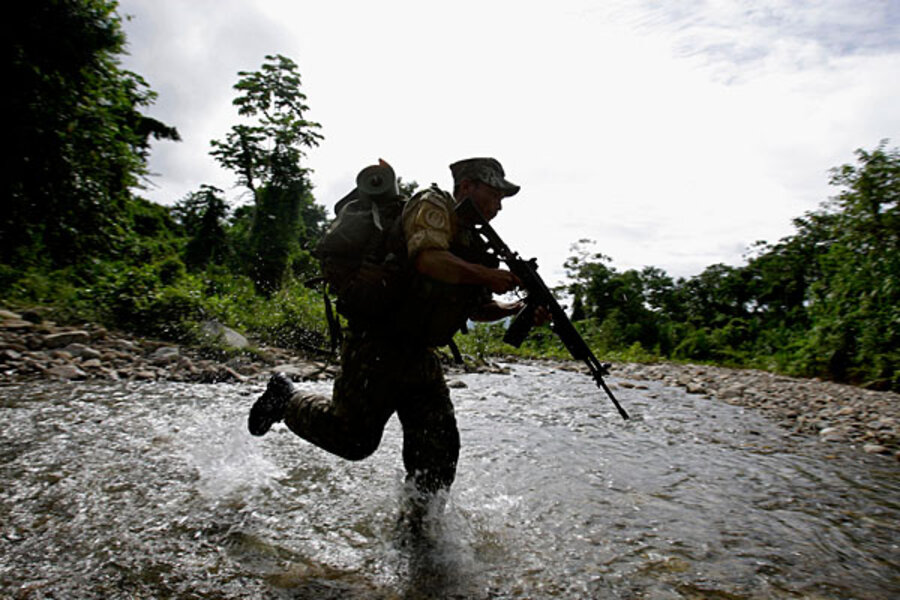Peru's newly sworn-in Humala will face remnants of Shining Path
Loading...
| Lima, Peru
Peru’s Maoist Shining Path insurgency should be a thing of the past. The main leaders were arrested nearly 19 years ago and remain behind bars, where instead of inciting world revolution, they have been calling for a “political solution” and fighting for visitation rights and other little perks.
This Andean nation is also vastly different from May 1980, when the Shining Path burned ballot boxes in a small mountain hamlet, launching its 12-year war against the state. Nearly 70,000 people were killed during the conflict, 56 percent of which were attributed to the Shining Path by an August 2003 report from the Truth and Reconciliation Commission.
Despite all the changes, President Ollanta Humala, who was sworn in today, will be the seventh president since 1980 to try and wipe out the Shining Path. He pledged to do as much during his victory speech on June 5, calling the rebels “insane terrorists.” The task will not be simple.
While politically and military defeated, Shining Path factions have tried to stay alive in two areas of Peru’s vast jungle region, claiming the revolutionary mantle and continuing to inflict losses on security forces and the civilian population. At the same time, the old guard, including a number of leaders who have been released from prison after serving their sentences, have formed a legal political party, the Movement for Amnesty and Fundamental Rights (Movadef). The party advocates for amnesty and release for all “political prisoners.” This would include Shining Path founder and leader, Abimael Guzmán.
“This is a multifaceted problem that is not only about armed factions operating in the jungle. There is a political component that is trying to rebuild. It is not massive, but it is there the same way it was there in 1980 when no one paid attention,” said Jo-Marie Burt, a government and political science professor at George Mason University and author of a book on political violence in Peru.
“It is quite astonishing that they persist after more than three decades,” said Ms. Burt.
The largest armed faction operates in the southern jungle, in a swath of rugged terrain known as the Apurimac-Ene River Valley (VRAE). It is led by Víctor Quispe, who joined the Shining Path in the early 1980s, when nearly 75 percent of the country was under a state of emergency because of terrorist activities. Mr. Quispe’s group has killed eight soldiers in the past two months, including five who died in an ambush on the eve of Humala’s election and two killed on July 19. They have also been blamed for the assassination of two civilians in July.
A smaller group operates in the Upper Huallaga Valley, in the northern jungle. It is run by Florindo Flores, or “Comrade Artemio,” the only historic Shining Path leader still at large. The Huallaga Police Front reports that Mr. Flores’ group has killed five peasants since June, accusing them of being police informants.
Humala, a retired lieutenant colonel who headed an anti-subversive unit in the Upper Huallaga Valley in the early 1990s, has said that one of the first orders of business when he is president will be to sit down with military and police leadership to formulate a plan to “wipe out the scourge” of terrorism. But Fernando Rospigliosi, who served twice as interior minister during former President Alejandro Toledo’s government (2001-2006), said Humala will not have an easy time eliminating the remnants of Shining Path.
“The first thing needed is a complete review of the current strategy, which has not worked. The military in the VRAE has focused on conquering physical space, but this is not a war about territory. The terrorist forces are very fluid, which is why no major leader has been picked off,” Mr. Rospigliosi said.
While agreeing that there needs to be a new strategy, Jaime Antezana, who has studied the Shining Path for the past 20 years, maintains that there is nothing revolutionary about the armed factions. He said that they are simply armed bandits in the service of drug traffickers. “The VRAE group uses the Shining Path name as if it were a ‘franchise.’ They are not interested in political control, but in securing routes to move drugs out of the valley,” he said.
The Peruvian government believes that the Shining Path could be receiving around $15 million annually from drug funds to stay armed and maintain their clandestine networks. Peru is the world’s second largest producer of coca, from which cocaine is made, and the two armed factions operate in the regions containing Peru's principal coca fields.
Movadef, which has to tread a careful line because the Shining Path itself remains an outlawed party, rejects armed revolution as a means for political change, but it makes a distinction between the VRAE and Huallaga factions, calling the latter dogmatic and anti-historical.
The most recent issue of its newspaper, Vortice, included an open letter to Humala, calling on him to deal with the legacy of the war. “The great taboo in Peru is the internal war. And it is a trauma that lacerates and throws off balance national conscience.”





